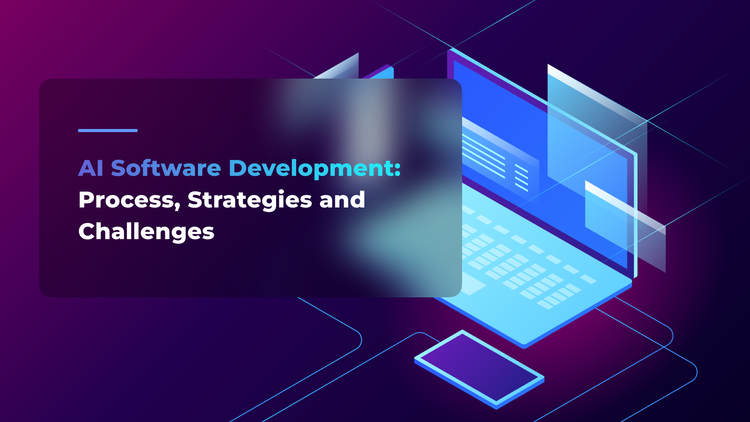AI in Telecom: Most Popular Uses Cases and Applications

With AI offering benefits like cost reduction, better customer experience, and optimized network operations, it’s no wonder more and more telecom companies are jumping on board. Market.us Research predicts that the global AI in telecom market will rise from $1.8 billion in 2023 to $23.9 billion by 2033. Also, AI implementation is promised to boost the annual revenue of telecom operators by up to $11 billion by 2025.
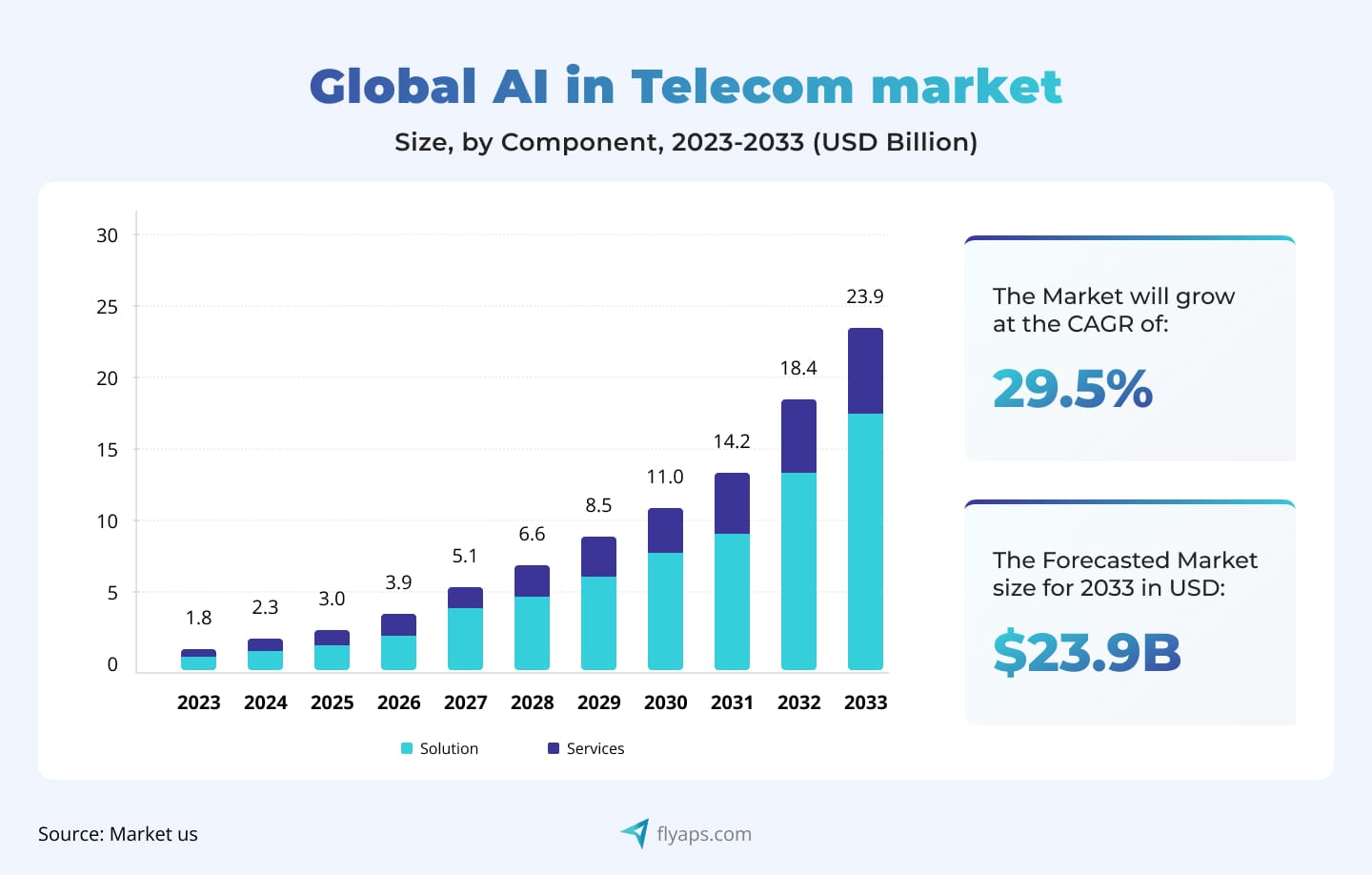
But despite all these positive forecasts, many telecom companies don’t rush adopting AI. One of the main obstacles for adopting AI in telecommunication is the inability to define a clear business case with solid ROI — often tied to uncertainty around how much AI actually costs to build in 2025.
Embracing AI just because everyone else is doing it isn’t the answer. You need a solid understanding of how AI can bring value and align it with your company’s overall business goals. But can AI really transform your operations?
At Flyaps, we are enthusiastic supporters of AI in telecommunications. We’ve been operating in the field for over a decade, witnessing AI technology going from a novelty to an indispensable part of the telecommunications industry. In this article, we will focus on the most common AI telecom use cases to help you understand whether artificial intelligence can potentially streamline your business. We will also provide real-life examples of telcos that have already achieved success thanks to AI, so keep reading.
The most common types of AI in telecom industry
When you start considering AI as a technology to optimize your business processes, you should clearly understand what kind of processes you plan to improve and with what AI-powered tech. For example, if you want to enhance network performance, you can use machine learning algorithms to analyze network traffic patterns and predict potential issues before they become critical. But when you need a chatbot to handle clients’ queries in real-time, you should focus on natural language processing (NLP).
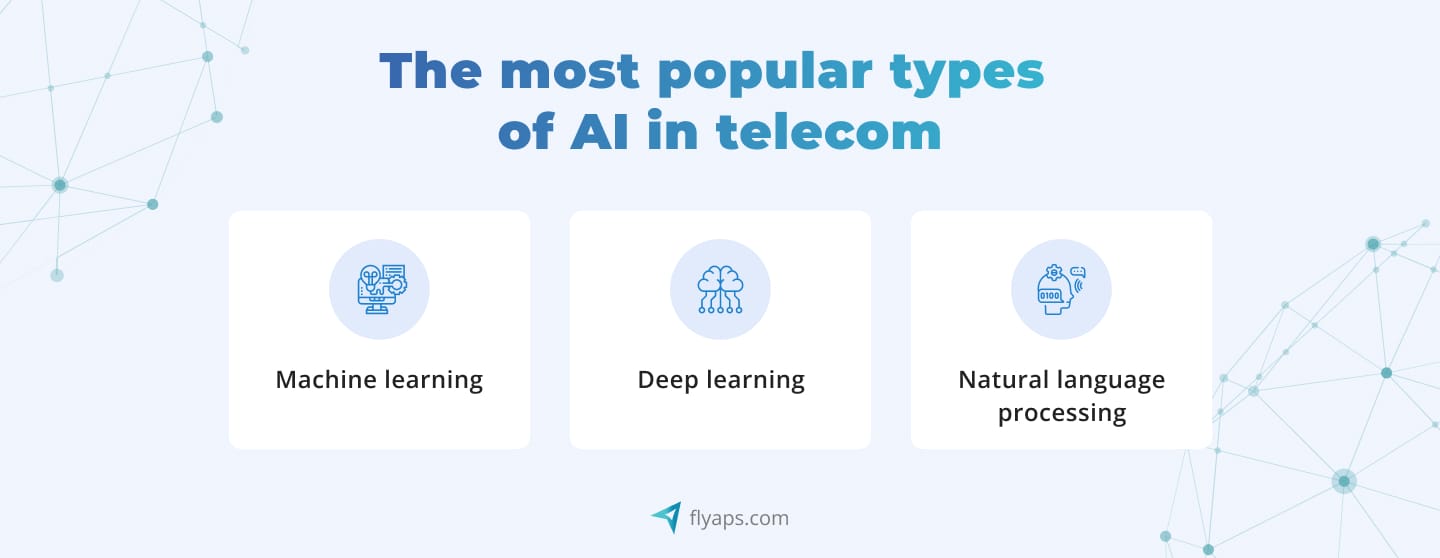
Although machine learning, deep learning, and NLP belong to the huge AI family, they serve slightly different purposes in telecommunications. If you're looking to implement any of these technologies, it's essential to understand the available AI development platforms that support their creation and deployment. Let’s overview them.
Machine learning (ML)
Machine learning is a subfield of artificial intelligence that uses algorithms and statistical models to perform specific tasks without human intervention. These models learn from data and improve their performance over time. For example, telecom companies apply ML algorithms to monitor the health of their equipment and infrastructure. By analyzing data from various sensors, these algorithms can predict when a piece of equipment is likely to fail and schedule maintenance before it happens.
Deep learning (DL)
Deep learning, in turn, is an ML technique that uses multilayered neural networks to perform complex tasks. These neural networks, often called deep neural networks, can learn and model intricate patterns from large datasets. Simply put, DL is a more advanced version of ML, and its applications in telecommunications are built on the same principles as machine learning, but with greater depth and complexity.
Let’s say your telecom company is looking to apply deep learning to protect your business from fraudsters. With DL in place, your system can analyze call records, transactions, and usage patterns to spot unusual activities. If it sees a sudden spike in international calls or data usage, it flags these as potential fraud. You can then suspend the account and contact the customer for verification.
Natural language processing (NLP)
NLP is one of the AI techniques most familiar to ordinary users as it’s behind day-to-day applications, like voice assistants, chatbots, and translation services. It’s a subfield of AI that uses ML to understand and interpret human language.
The most obvious example of using NLP in telecom is probably a customer service chatbot. If you have a telecom app on your smartphone, it likely features a chatbot. This chatbot handles common queries about billing, plan details, or technical support.
When discussing the use of AI in telecoms, it’s important to note that different AI techniques and technologies are closely intertwined to deliver comprehensive AI capabilities. For example, a telecom company might deploy an AI system that uses NLP to analyze customer messages and identify key issues. Simultaneously, ML algorithms, trained on historical data, can predict solutions and recommend appropriate responses.
AI can do more for your business—let’s find the best way to make it work for you. Check out our expertise and let’s discuss your next AI project.
See our AI servicesTop AI use cases in telecom
Digital transformation, widespread adoption of smartphones, and the growth of IoT in telecom are just a few factors moving the telecom industry forward these days. Such innovations increased the need for robust telecom infrastructure and reliable connectivity. Fortunately, AI and ML have stepped in to meet these challenges head-on.
Below, we’ll explore some of the most popular generative AI use cases for telecom and see how companies successfully adopted artificial intelligence to enhance their operations.
Network optimization
Thanks to AI in teleco, you can detect bottlenecks, optimize traffic routing, and predict potential problems. Here is how it works in a simple example. Let’s say a company implemented AI to improve traffic routing. In brief, it looks like this:
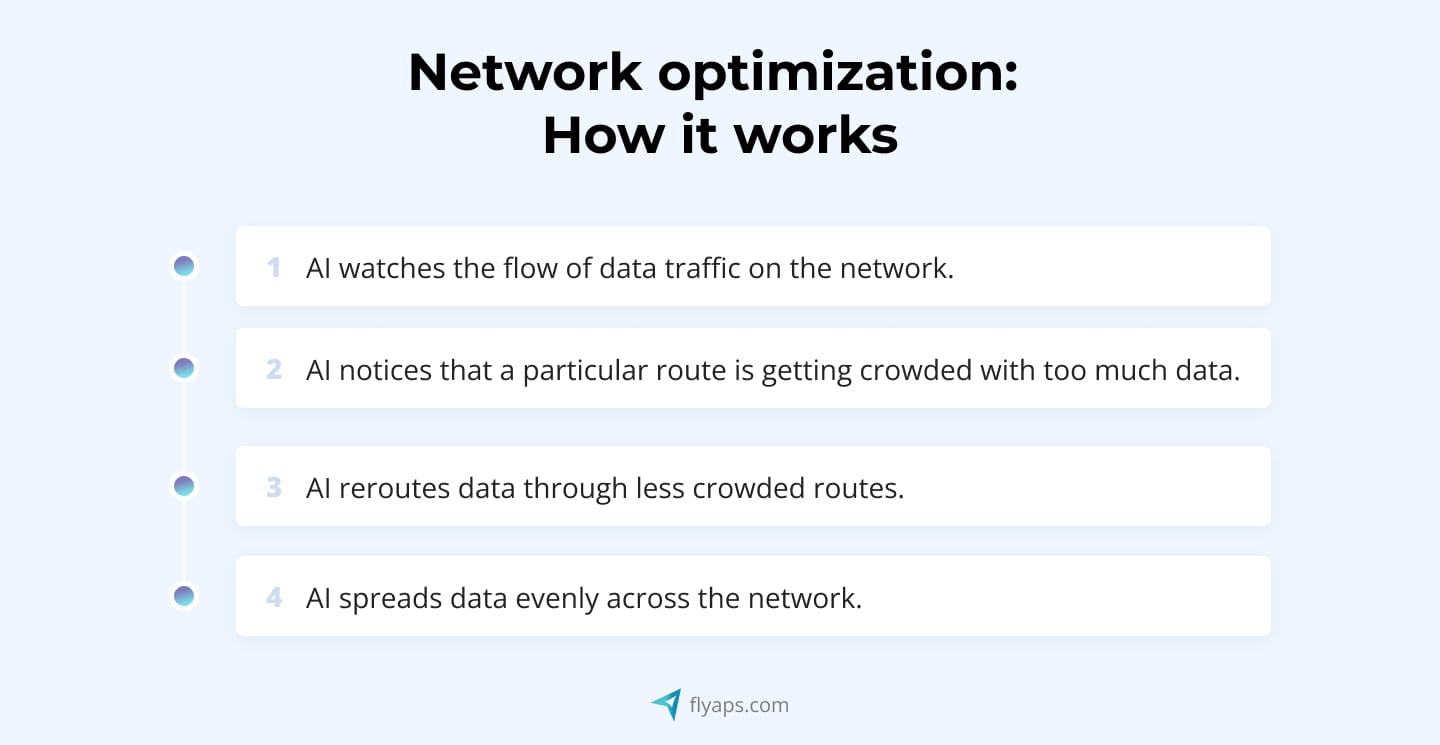
As a result, this approach lets you minimize downtime, enhance network reliability, and ensure seamless connectivity, even during periods of high usage. For instance, Deutsche Telekom uses AI to optimize the part of their network that deals with radio signals – radio access network (RAN). The company is now testing a new AI-based solution to enable the radio network to monitor its own performance, identify issues, and take corrective actions automatically, without human intervention. For example, in the near future, the system is promised to adjust settings to improve signal quality or network efficiency.
Predictive maintenance
AI-powered predictive maintenance is making a significant impact on telecom operations. Take AT&T as an example. They’ve created an End-to-End Incident Management Platform, which uses AI-powered predictive models and statistical algorithms to prevent network outages. This platform scans over 52 million different network records, devices, and customer circuits, analyzing over 1.2 trillion daily network alarms and alerts. By detecting patterns within these massive datasets — often in real-time — AT&T can minimize network service outages and enhance customer satisfaction.
Fraud detection
AI algorithms can monitor network traffic 24/7, scrutinizing every data packet and user interaction, and also detect anomalous patterns or behaviors that human analysts might overlook. For instance, AI can identify unusual call routing, detect discrepancies in call duration, or pinpoint cases of SIM card cloning. By leveraging AI-driven fraud detection, telecom companies can not only safeguard their revenue but also protect customers from unauthorized charges and suspicious activities. The speed of AI detection and automated responses significantly reduces the window of opportunity for fraudsters, enhancing overall network security.
For example, Orange uses AI and ML to combat fraud on its international network. They have developed Khiops, a tool that accelerates information analysis and data preparation. It automatically analyzes call databases to calculate a probability rate, known as scoring. This helps data analysts focus on high-probability fraud cases. The tool analyzes over 200 million international call reports daily and generates around 65,000 alerts, enabling Orange to block fraudulent numbers effectively.

Customer service automation
AI chatbots can handle routine customer queries, provide account information, and assist with common troubleshooting issues. They are available 24/7, so your clients can get assistance at any time, leading not only to faster response times, but also improved accessibility. Moreover, AI-powered NLP technology enables chatbots and virtual assistants to understand and respond to customer inquiries in natural language. This makes interactions with AI systems more conversational and user-friendly, improving the overall customer experience.
As we’ve mentioned earlier, almost all companies in telecom have AI-powered chatbots, and Vodafone is not exception. VOXI, a mobile phone brand owned by Vodafone, launched an LLM generative AI chatbot in collaboration with Accenture. This chatbot can engage in human-like interactions and handle sophisticated customer requests. The initiative aims to accelerate the use of generative AI models across VOXI and Vodafone.

Energy efficiency
For telcos, the rollout of 5G networks usually means an increase in traffic and, consequently, more energy consumption. The cost of electricity is on a steady rise, and environmental responsibility is a growing concern, so telcos face a critical dilemma: how can they meet the constant demand for high-speed connectivity while simultaneously minimizing their carbon footprint and reducing operational costs? This is precisely where the role of AI in telecommunications is crucial.
A compelling example comes from Telefonica Spain, which tested a feature called Deep Sleep Mode. This energy-saving functionality was deployed in Madrid at a site with a 5G configuration. Supported by AI and machine learning algorithms, the company achieved remarkable savings of up to 8% in total consumption over a 24-hour period and up to 26% during low-traffic hours. This not only reduces operational costs but also aligns with sustainability goals, making telecom networks more environmentally friendly.
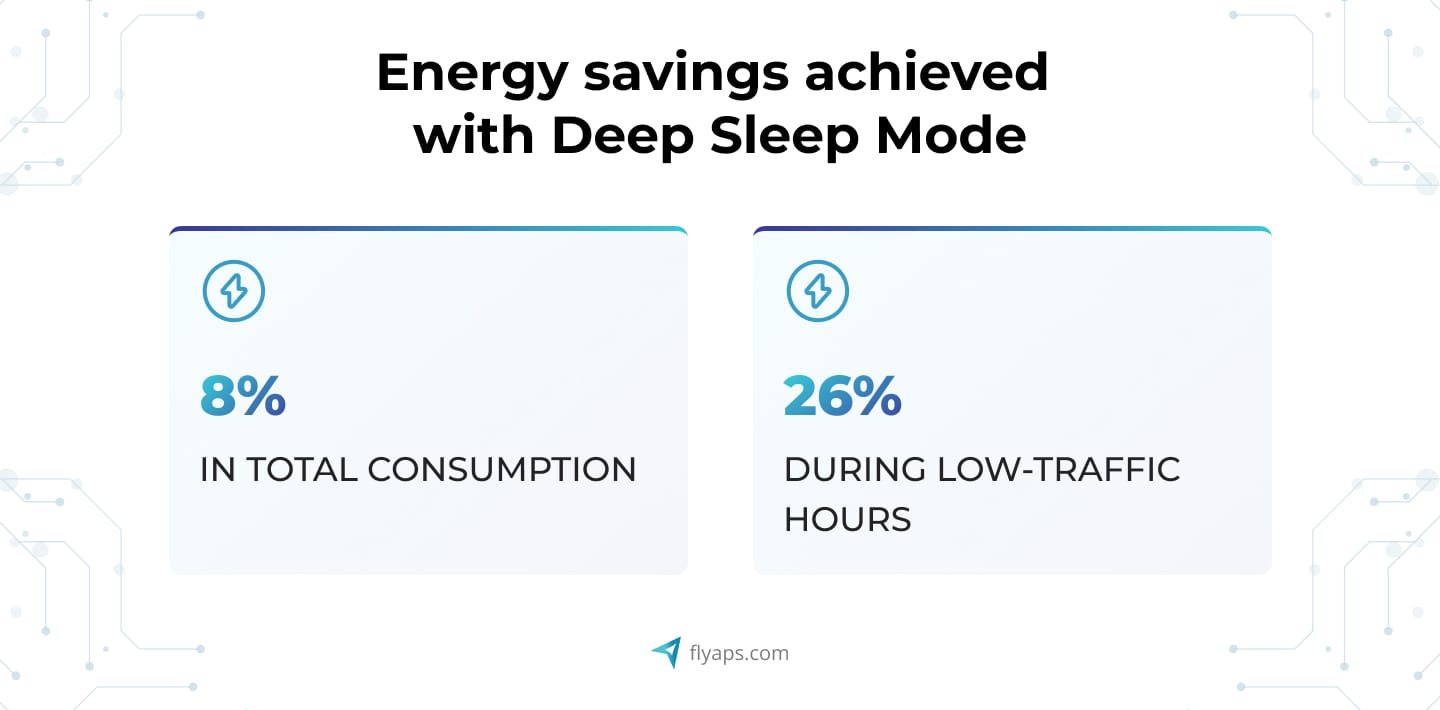
These applications are just the tip of the iceberg – AI solutions have the potential to transform countless processes within your company and the telecom industry as a whole. Here are some other ways you can use AI for telecommunications to drive revenue.
More opportunities to use artificial intelligence in telecom
If you thought that we’re done talking about ways telecoms can adopt AI, you’re wrong. There are even more opportunities for companies to leverage AI in telecom, so let’s have a look at them.
Personalized marketing
First off, let’s briefly remind what personalized marketing is. It’s a strategy that uses customer data to tailor marketing messages based on individual preferences and behaviors. Instead of sending the same message to everyone, personalized marketing creates targeted campaigns that are relevant to each customer based on their past interactions, purchase history, browsing behavior, and other data. And implementing AI might greatly help in this respect.
A telecom company might implement ML algorithms to analyze what types of services and features each customer frequently uses. Based on this data, they could create personalized offers, such as discounts on data plans or special promotions for frequently used services. For example, Vodafone uses AI-generated personal recommendations to make offers in 12 existing service and product types in the consumer sector.
Robotic process automation (RPA)
RPA is a technology that uses software robots or “bots” to automate repetitive, rule-based tasks typically performed by humans. In the telecom industry, these tasks typically include data entry, invoice processing, handling customer queries, and more. RPA can be also integrated with AI solutions to improve efficiency and enhance customer service. Here is how it works in simple words.

Let’s say a customer sends an email about a billing issue. An RPA bot first captures the email and extracts relevant details. AI then analyzes the email’s content to determine that it’s a billing dispute. Then, the AI system checks the customer’s account history and verifies the issue. If it’s a common problem, the RPA bot automatically applies a credit or adjustment and sends a confirmation email to the customer. If the issue is more complex, the bot forwards the case to a human agent with all the necessary details, reducing the time the agent needs to spend on preliminary tasks.
Internet of Things (IoT)
The main idea behind IoT is to gather and process tons of data from various sources, such as sensors, meters, and other devices. This data is then used to gain insights and make informed decisions. AI, in turn, is the technology that offers capabilities to significantly improve data analysis by using advanced algorithms and ML techniques.
In the telecom industry, companies can deploy IoT sensors to monitor the performance of its cell towers. These sensors collect data on various parameters like temperature, humidity, signal strength, and power consumption. If the AI system notices a gradual increase in temperature and a corresponding drop in signal strength at a particular cell tower, it might predict that the cooling system is failing. It helps to prevent service disruptions and reduces maintenance costs.
Or let’s take a more specific example. T-Mobile collaborates with municipalities to create smart city solutions that use IoT and AI. These solutions include smart lighting, traffic management systems, and environmental monitoring. AI algorithms analyze data from connected sensors to optimize city operations, reduce energy consumption, and improve urban living conditions.
How industry leaders use AI for telecom
Artificial intelligence in telecommunication isn’t a new concept for industry leaders. Companies like Vodafone and Verizon have already demonstrated that telecom and AI go hand in hand to enhance efficiency and increase profit.
Here’s what telecom giants have achieved with AI.
How Verizon unveils AI-powered tools to enhance service quality

Verizon launched generative AI applications to simplify interactions and increase customer satisfaction across all service channels. These tools help customer service representatives provide accurate information quickly and, therefore, create meaningful customer relationships. Here are the key AI-powered tools deployed by Verizon:
- Personal Research Assistant helps employees efficiently find information to address customer inquiries, leading to a 95% inquiry resolution rate.
- “Fast Pass” to resolution pairs customers with the most suitable customer care representative for their specific needs.
- Personal Shopper/Problem Solver analyzes customer profiles to assist employees in delivering tailored solutions quickly, reducing transaction times by two to four minutes.
- “Segment of Me” provides personalized offers and products to customers based on their unique preferences, increasing engagement and reducing churn.
Ways Vodafone adopts AI technologies to improve customer experience

Vodafone, in collaboration with Google Cloud and Genesys, has launched TOBi, a digital chat assistant, and a new NLP-driven Speech Interactive Voice Response (IVR) system. TOBi uses natural language processing to handle 70% of customer queries through digital channels, while only 30% go to human agents.
Let’s consider one more example. Partnering with Eviden, Vodafone launched an AI-powered virtual receptionist designed to enhance guest experiences at hotels. This virtual assistant can communicate in multiple languages and seamlessly interact with the hotel’s systems and third-party applications to provide comprehensive support, including restaurant reservations and booking tickets.
How Flyaps can help you adopt AI in telecommunications
Here at Flyaps, we’ve gained expertise in developing AI solutions in various fields, but telecommunications has always been our favorite. Let’s explore how we can apply our experience to benefit your telecom business.
AI consulting for telecom
We can assess the specific needs and challenges of your business, helping you identify areas where AI can bring the most value. Our experts can create a roadmap for AI integration, including selecting the right AI technologies.
Custom development of AI-based solutions
We can design, develop, and deploy a custom AI solution that will perfectly address various use cases, such as network optimization, customer service automation, fraud detection, and predictive maintenance. Custom development ensures that AI applications are precisely aligned with your company's objectives and infrastructure.
Data management and integration
Our developers can assist in collecting, cleaning, and managing your data from various sources. They can design data pipelines and integration solutions to ensure seamless data flow to AI systems. Data integration is crucial for AI algorithms to have access to the right information for analysis and decision-making.
Integration with existing systems
Integrating AI solutions with existing telecom systems and infrastructure can be complex. We can ensure seamless integration, allowing AI applications to work in harmony with legacy systems and other software tools used by your telco.
Ready to empower your telco with AI? Drop us a line to start!
From cloud migration to telecom-specific AI solutions, we’ve helped major players like Rakuten and Orange make their telecom operations smarter. Check our capabilities and let’s discuss your next solution.
Let’s collaborate

